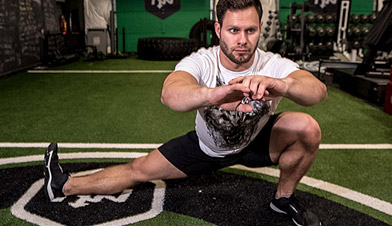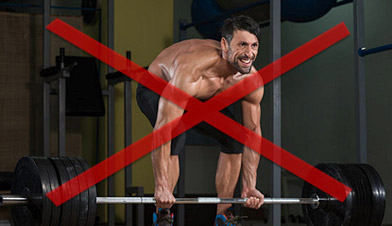7 BODYBUILDING INJURY PREVENTION TIPS EVERY LIFTER SHOULD FOLLOW

Injuries are one of the biggest setbacks when it comes to building muscle over the long term.
In this article, we’re going over 7 key injury prevention tips every lifter should know.
When you go to the gym with the goal of building muscle, you need to be training hard and striving for consistent progressive overload from week to week.
But it’s important to remember that you’re not just stressing your muscles during training. Your joints and connective tissue also experience a considerable amount of stress as well.
Over time, this can really add up and lead to long-term problems if you’re not executing your workouts in a way that minimizes the risk of injury.
Building muscle and preventing injuries are co-dependent factors.
Your entire ability to make progress and increase your size and strength hinges on your joint health.
If you’re not injured and haven’t been injured in the past, then you may not be too worried about it or think it will ever be an issue for you.
But trust me, when you eventually do end up hurting your lower back, shoulder, elbow, knee, or whatever else, you’ll most definitely regret not implementing the proper injury prevention steps into your program.
This is especially true when you consider that some injuries can throw off your workouts for several months, years, or even permanently in some cases.
Always keep in mind that the goal here isn’t to simply be in the gym for the next six months or even five years.
Bodybuilding and fitness is something you’ll be adopting for life, and every decision you make in the gym should reflect that fact.
If you want to be healthy and able to train hard over the long term, then ensuring your joints and connective tissues are strong and healthy should be treated as a primary, baseline factor.
Following these tips will not guarantee that you’ll never get injured, and the majority of people who train for many years will probably experience at least a few minor injuries that pop up here and there.
However, the advice found below will hugely reduce your chances of getting injured as well as the severity of the injuries that you might encounter.
7 Ways To Prevent Injuries
Tip #1: Perform A Proper Warmup

Tip number one for preventing injuries — before you even jump into your actual workout — is to perform a proper warmup first.
For most average lifters out there, a pre-workout warmup usually consists of nothing more than a few light reps before the first main exercise at best.
In a lot of cases, the warmup process gets skipped altogether.
This is something I would highly advise against.
Why? Because a well-rounded warmup routine is a highly effective way to minimize your risk of injury.
Warming up will prepare your mind and body for the workout ahead by increasing core temperature, improving joint mobility, boosting joint lubrication, as well as getting your muscles and nervous system firing in preparation for the heavier weights to come.
There are many different ways that an effective warmup can potentially be done.
In general, a warm-up should only take about 10-15 minutes of your time to complete.
I prefer to use a mixture of certain dynamic movements, stretches and some self-myofascial release.
Additionally, incorporating a few weight acclimation sets prior to your first main compound exercise is an important injury prevention step as well.
The basic idea here is to start off with a very light weight for higher reps, and then gradually increase the weight while lowering the reps and working up to the maximum weight you’ll be using for your first muscle building set of the workout.
Here’s the basic template you can use…
Set #1: 50% x 8 reps
Set #2: 75% x 3 reps
Set #3: 100% x 1 rep
So, if dumbbell presses were the first exercise in your workout and you were planning to use 80 pound dumbbells on your first set, you’d warmup with 40’s x 8, 60’s x 3, and 80’s x 1.
Tip #2: Utilize Correct Form & Technique At All Times

Injury prevention tip number two might seem to be common sense, but if I simply take a look around the gym at any given time it’s obvious that a high percentage of novice lifters don’t take this advice to heart.
A lot of exercises might seem pretty basic on the surface, but once you really start diving into the nuances of each individual lift, things get a bit more complicated.
If you want to prevent injuries (and maximize muscle stimulation as well), you need to ensure that you’re performing all of your exercises with proper form and technique.
And when I say proper technique, I really do mean proper technique and not just glancing at a quick 10 second tutorial online and then jumping straight into those heavier sets.
If you want to prevent injuries over the long-term and experience the best muscle building results possible, then take the time to do your research first.
Go through each individual exercise you’re performing and learn about the smaller subtleties that are involved. If you’re still a novice then practice the movement using lighter weight and slowly build things up over time.
You also need to make sure that you’re not using excessively heavy weight during your sets.
If you’re not able to lift the weight through a full range of motion while using correct form throughout the entire set (and without any assistance from a spotter), then this is a clear sign that the weight you’re using is simply too heavy and that you need to scale back.
Heaving around massive amounts of weight using a lot of momentum and sloppy technique is probably the single biggest cause of weight training injuries in the gym.
Neglecting form for the pursuit of lifting heavy weights will significantly increase the strain on your joints and connective tissues throughout your workout.
It’s possible that you won’t run into any problems in the short term. You may even be injury-free for several months or even years. However, over the long-term, it’s a virtual guarantee that consistent ego lifting will catch up to you.
So, leave your ego at the door and stop piling unnecessary weight onto the bar just to try and impress those around you.
Yes, progressive overload is the underlying driver of muscle growth, meaning that you need to strive for consistent improvements in your lifting performance over time and add more weight to the bar on your lifts. However, when you do increase the weight on a certain lift, your technique should always stay exactly the same each time.
If you’re ever sacrificing form in order to add more weight, then you’re trying to progress too quickly and you need to slow down and be more patient.
Tip #3: Moderate Your Training Intensity

Tip number three to prevent injuries is to moderate your overall training intensity and keep it within an appropriate range.
Training roughly 1-2 reps short of muscular on the majority of your sets (3 reps at the most) is a good level to aim for. It’s high enough to stimulate growth optimally but low enough that you won’t be putting excessive strain on your joints and connective tissues.
Going all the way to failure can be fine on certain movements (particularly on smaller isolation exercises), however, it should be used sparingly and cautiously.
When you’re close to failure, you’re in a high fatigue state. In this state, it’s much easier for your form to slip.
Advanced lifting techniques such as forced reps, rest-pause reps, or heavy negatives should also be kept within limits and only used once in a while, and for novice lifters, they probably don’t need to be included at all.
You most definitely do need to be training hard and pushing yourself close to the limit in the gym to optimize your gains, but going too far overboard will often work against you rather than for you.
Tip #4: Moderate Your Volume & Frequency

The fourth tip for preventing weight training injuries is to moderate your total volume and frequency for the week.
Despite performing the majority of your sets 1-2 reps short of failure, performing too many total sets can also lead to problems if you’re not careful.
Keep in mind that more volume is not necessarily better.
Of course, every person is going to tolerate weight training differently. A range of factors — such as one’s individual genetics, body type, experience level and nutrition — will all affect how well a given person responds to volume and frequency.
Despite individual differences, most people tend to respond well to the following guidelines:
- Directly hitting each muscle group somewhere between 1.5-3 times per week.
- Performing around 8-15 total weekly sets for large muscle groups and 4-8 sets for smaller muscle groups.
Some people will be able to go higher than these guidelines. This is especially true if the increased volume is being utilized temporarily for an overreaching cycle.
But in general, somewhere within these ranges will strike a good balance between stimulating muscle growth effectively and giving your joints and connective tissues enough recovery time throughout the week.
It’s also important to remember that regulating total training volume applies to both weight training and cardio.
Low impact forms of cardio such as walking or cycling won’t be a concern in most cases, but higher intensity methods such as sprinting, outdoor jogging on hard surfaces, plyometrics, and even hitting a heavy bag are all going to place your joints under more stress, meaning these forms of exercise should be moderated too when done in combination with weight training.
Tip #5: Train Your Entire Body Equally

In terms of actual workout structure, another important injury prevention guideline that tends to get overlooked is to make sure that your overall selection of exercises is properly balanced.
Ideally, every muscle group should be trained with equal focus and equal intensity throughout the week.
If one set of movement patterns is consistently over-emphasized while others are neglected, certain joint and muscular systems can end up being pushed out of their optimal position and firing pattern.
For example:
- Putting more focus on horizontal pressing versus horizontal pulling is a very common mistake in most training plans and can lead to shoulder instability.
- Doing too many quad-dominant movements compared to posterior chain movements can lead to issues with the knees.
- Training your abs without any lower back work can lead to a core imbalance.
These are just a few of many examples.
In general, each movement pattern you perform in your training plan should be balanced out with an equal amount of its opposite movement pattern.
For example:
- Horizontal presses should be matched with horizontal pulls.
- Vertical presses with vertical pulls.
- Compound quad movement with compound hamstring movements.
Tip #6: Maintain Good Postural Habits

Injury prevention tip number six is to work on maintaining proper posture during your day-to-day life outside of the gym.
A well-balanced joint and muscular system isn’t just about what you do in the weight room. Your regular resting posture and movement patterns play a fundamental role in maintaining good postural habits as well.
Actively focusing on improving posture is especially important today where people are spending hours and hours in a seated position hunched over their laptops and smartphones.
Improper posture can cause a range of issues all throughout your body from your head all the way down to your ankles and feet.
Remember that your body as a whole is interconnected. When you develop dysfunction in one particular area, this usually causes a cascading effect throughout the rest of your body.
The topic of proper posture is beyond the scope of this article, but just keep in mind that how you move (or don’t move) your body throughout the day has a significant effect on the health of your joints and your connective tissues and is an overlooked cause of bodybuilding injuries.
You can help to improve your posture by:
- Staying mindful of your daily posture and movement patterns.
- Limiting how much time you spend sitting.
- Taking regular breaks to stand and walk during work sessions.
- Implementing certain rehab techniques such as self-myofascial release, muscle activation exercises, and stretches depending on your individual needs.
Tip #7: Incorporate Regular Deloads

Tip number seven is to incorporate regular deloads into your plan.
A deload is where you either continue training on your normal routine but with a 50% reduction in the weights you use, or simply taking an entire week off from the gym altogether.
I’d recommend incorporating a 1-week deload for every 6-12 weeks of consistent training.
A deload week may seem counterproductive, but it’s a very effective way to prevent injuries by giving your joints and connective tissue a well-deserved break from the previous weeks of training.
What If I Follow These Tips And Still Get Injured?
If you do find that you’re running into issues with joint pain even though you’re following all of the points in this article, this doesn’t necessarily mean you’ve done something wrong.
Injuries are a normal part of intense weight training, especially for someone who has been hitting the gym seriously for years.
If the pain is fairly minor and it’s only occurring during a certain exercise, the first step you can take is to experiment with different variations of that exercise. This experimentation will allow you to find a comparable movement that’s more comfortable for you.
For example, this could mean switching from a barbell press to a dumbbell press or a cable press. Or it could mean swapping out a barbell squat for a dumbbell split-squat or hack squat, or changing from pullups to lat pulldowns. These are just a few examples of many.
There’s no single exercise which is an absolute must for building muscle, and it’s usually possible to find a similar exercise variation which still hits the area you’re targeting but without the added joint discomfort. You can switch exercises temporarily while you work on treating the root cause of your injury.
Another method you can use is to switch to lighter weights and higher reps. Higher rep sets can still produce comparable muscle growth as long as they’re taken within a few reps of failure, and this will allow you to still get in an effective workout but while reducing the strain on your joints.
In more serious cases where the pain is severe regardless of which exercise or rep range you use, taking time off from that movement (or in some cases from the gym altogether) is probably a good idea so that you can get the injury properly assessed and treated.
Remember, if you continue to push yourself when something is clearly off, that will almost always make things worse and can produce long-term consequences which could put you out of action for a much longer time.
It’s better to take six weeks off to let injuries heal, rather than pushing through pain and then having to take six months off.
Minor aches and pains can be worked through as long as you’re careful, but significant joint discomfort should be taken seriously and ideally be treated by a professional before you get back to your regular training routine.
Bodybuilding Injury Prevention: Quick Summary
If you truly want to build muscle, gain strength and transform your body effectively, consistent hard training in the gym with a focus on progressive overload is the only real way to get there.
Just don’t forget that those intense workouts aren’t merely stressing your muscles alone; your joints, tendons, ligaments and connective tissues also take on a good portion of the load as well.
7 tips you can follow to minimize the risk for injury include:
- Performing a proper warmup.
- Utilizing correct form and technique at all times.
- Moderating your training intensity.
- Moderating your weekly volume and frequency.
- Training your entire body with equal focus.
- Maintaining good postural habits outside of the gym.
- Incorporating regular deloads.
While these tips won’t guarantee that you’ll never get injured, they’ll greatly reduce the chances if consistently implemented.
If you found this article helpful, make sure to sign up for your FREE custom fitness plan below...




